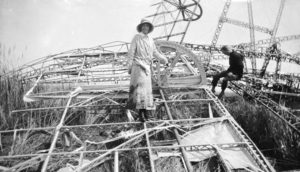Monday Jan 7th, 1918
Grand day. Quite a difference from the previous days. No parades and nothing doing. Poor food, nearly starving. Went down to wash & during washing, air raid commenced. Took to the dug outs for safety, nothing damaged. Wrote home 5th letter. No money, broke to the wide. Warned to leave for Summer Hill tomorrow – Tuesday.
Frank certainly had a testing day, experiencing his first air assault and at the particularly inopportune moment when he was attempting to bathe. After more than three weeks since he left Marseilles, Frank also has no money and no signs of any pay.
Air raids

By the time Frank arrived in Salonika air attacks were a common feature – particularly as a tactic to disrupt the enemy’s rear – those operations beyond the range of ground artillery. In late 1915 and early 1916 the raids had been made at night by German zeppelins launched from Hungary. However zeppelins were unwieldy, imprecise and vulnerable to even basic defensive strategies. For example, Airship LZ.85 was shot down on its third outing on the 5th of May 1916 by fire from HMS Agamemnon and a torpedo boat in Salonika harbour.¹ The skeleton of this craft, along with others over the course of the war, became a tourist attraction on Salonika’s waterfront.
While the zeppelin raids had little impact, the increasing use of aeroplanes as an offensive force made air raids and dog fights more permanent and deadly features of the war in Salonika. The Germans and Bulgarian aircraft had a distinct advantage due to the prevailing NNW wind that blew down the valley of the Vardar river. However the early raids, although irritating, often resulted in minimal damage. This all changed in early 1917 with the arrival of specialized German bombing groups.
Kagohl One
The Kagohl, an acronym of the German for ‘Combat Wings of the Supreme High Command’, were created in December 1915 as part of a reorganization of the German air forces. Initially deployed on the Western Front, within a year some Kagohl had relocated to the Eastern Front. In early 1917, Kagohl One was sent to Salonika after the fighting with Rumania ended. It immediately targeted the network of Allied camps behind the lines. Over 300 men at the Summerhill Camp were killed in just one raid in late February 1917. A couple of weeks later, more than 60 were killed in a raid upon one of the hospitals.
British aeroplanes
Aerial attacks remained a feature of the Macedonia Front for the rest of the war. The British air forces in Salonika had been at a disadvantage in their aircraft since the early days. However in early 1918, at last, they were given improved aeroplanes in both the SE5a and Sopwith Camel fighters. See the following video from 1917 for some footage of these famous, fragile aircraft.
In April 1918 the Royal Flying Corps and the Royal Naval Air Service combined to form the Royal Air Force. At the same time, in Salonika the 150 Squadron, a dedicated fighter unit, was established. With this, the improved aircraft and the withdrawal in May of Kagohl One, the way was paved for British and Allied air supremacy on the Macedonian Front. All this happened in good time for the big offensive of September 1918.
References & further reading
¹ ‘Under The Devil’s Eye. The British Military Experience in Macedonia 1915-18’ by Alan Wakefield and Simon Moody (Pen & Sword)
* Photo of Zeppelin skeleton in Vancouver Archives



One thought on “Air raids -January 7th, 1918”
Comments are closed.